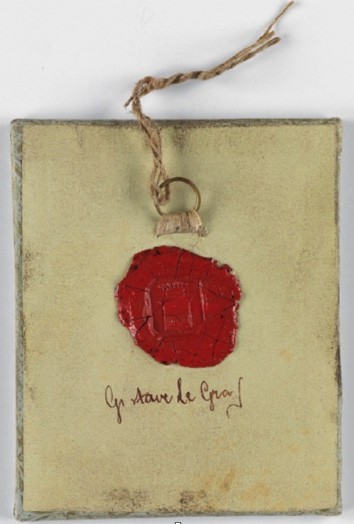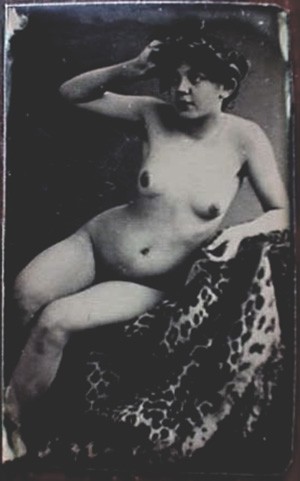On Exhibit: Shape of Light--100 years of Photography and Abstract Art at London's Tate Modern: Now-October 14, 2018
Forum Auctions Launches Its First Photo and Photobook Auction in London on Friday, June 1st.
Bonhams Auction House May Be up for Sale Again
James Ganz to Join the Getty as Senior Curator of Photographs
Photo Books: From Paper Promises to Tintypes to a Land of Epic Battles

Front of a daguerreotype claiming to be by Gustave Le Gray withdrawn from the recent Swann Gallery Photographs Auction.
A number of daguerreotypes with reportedly fraudulent signatures, labels, wax seals, etc. have been recently discovered on the market. Their source appears to have come from Poland and/or East Germany, according to major photo collector/investor Michael Mattis and other European dealers and collectors.
Several items were offered for sale on Polish and German eBay, and one—a Gustave Le Gray--even appeared at a recent Swann Gallery Auction after it was bought on eBay and consigned to the Swann sale, reportedly along with one by Daguerre that didn't make it into the sale.
The reported forgeries so far include daguerreotypes with ink, embossed, punched and engraved signatures (and other details), and labels that were copied and ink jet printed by the likes of Louis Daguerre, Gustave Le Gray, Auguste-Rosalie Bisson, Louis-Auguste Bisson and Th Jacobi.

Back of this daguerreotype.
The supposed forgeries are of a relatively high quality when examined only through photographs—good enough in fact to reportedly entice two AIPAD 19th-century dealers and Michael Mattis to bid on the "Le Gray" lot at Swann, although when physically examined carefully, the problems were more obvious. Mattis prevailed at the auction, but once questions were raised, the lot was withdrawn and the sale of this object was quickly cancelled.
This was not the first time that misleading or fraudulently identified daguerreotypes and other photographs have been put in auctions. EBay in particular has often been used to sell questionably identified photographic material because it is easier to pass off such items than those you can physically examine, but such material has also appeared in the past at Artcurial, Christie's, Bonham's, Butterfield's, Swann, Yann Le Mouël, Guernsey's and other auction houses, before--mostly--being withdrawn prior to sale.
It should always be a necessity to examine photographs prior to bidding at auction where there often isn't a reliable way to return dubious material. Or at least buy from or through reputable and experienced photo dealers.
Unfortunately most of the major auction houses no longer have experienced personnel, especially after both Denise Bethel and Philippe Garner retired. Chris Mahoney, who recently moved from Sotheby's to Phillips, may be the last person on the U.S. and London auction scenes with extensive experience with daguerreotypes.
I should mention that such issues of fraud and even outright counterfeiting are even more prominent and usually harder to detect in other art media, such as paintings, prints, furniture and design, contemporary art/photography, and sculpture. Over a billion dollars in counterfeit paintings alone reportedly went through the auction and major gallery systems in recent years, according to several media reports, such as the Art Newspaper.
The issues for photography have been much more limited and have been quickly uncovered compared to other collectible areas, which makes it safer for collectors. Just normal caution is required with photography, but should be exercised. If you don't feel that you have the basic knowledge, there are experts and sources to help you get this knowledge. The Daguerreian Society is one such group, and members are very open with their help.
Even on eBay with its so-called "guarantees" through PayPal, you may still find yourself eating the cost of bad photographs (or other art media). Those guarantees are very difficult to enforce. I was involved as an expert in one such case for a fellow photo dealer that involved a huge amount of work and forms for just a few hundred dollars purchase. This case involved a dubious character in France who would buy miniature cases readily available for $5 or so apiece and then pop in $20 lantern slides and call them ambrotypes. Several French friends and I had been trying to get him kicked off eBay for years. Even when eBay finally did, he merely changed his eBay handle by a number and started selling once again.
EBay has--in the past at least—even threatened dealers who actually raise the alarm to others on such dubious descriptions, preferring to treat such issues as just a matter of competing opinions without reviewing the credentials of each party or the actual issues raised themselves. The best way to avoid issues is to know the dealer you are doing business with, and don't let greed get in the way of your due diligence. An honest dealer will always offer return privileges if the item isn't as described, but then check to make sure that the description is clear.

Modern copy tintype on old plate with Civil War-era revenue stamp on verso.
Another earlier group of daguerreotypes originated from a small antiques dealer that took daguerreotype lessons from Harvey Zucker, who passed away recently and used to give such courses at his noted photo bookstore, A Photography Place. To be clear: Harvey had nothing to do with these daguerreotypes. That antique dealer, who used to set up in Lambertville, NJ, made less than ten images that I know of on old, rebuffed daguerreotype plates, which he then replaced into their 19th-century cases. These modern images initially appeared in the catalogues of many of the auction houses that I noted above, and included daguerreotypes of a clown, a scarecrow, a fisherman, fish hanging on a fence, a copy of Abraham Lincoln, etc. It was dealers like myself, William Schaeffer and Christopher Wahren who warned several of the auction houses about these, which had included them in their catalogs. Most have poor contrast and other easily detected issues, but uncasing them is usually necessary to fully detect these characteristics.
There have been other instances where hard images (daguerreotypes, ambrotypes and tintypes) have been altered or older images have been copied using these early methods. Cartes-de-visite and cabinet cards have also been altered and had cheap portraits replaced with inkjet prints of Indians, Civil War images, Circus people, etc. often on original 19th-century mounts. Copies of photographer stamps are often ink-jetted on the back of photographs. I've seen old tintype plates even with 1860s revenue stamps on the verso that were re-used to mislead people into thinking the images were done in the 1860s. There are often easily spotted characteristics (at least under magnification) that tip off the buyer if they exercise caution instead of excitement about such images.
Misidentification of a portrait is perhaps the most common and controversial issue. We've seen too many portraits misidentified as Billy the Kid, Jesse James, Abraham Lincolns, vice presidents, etc. on eBay and even on Wikipedia that most experienced observers don't think are accurate IDs, despite the sellers' "evidence" to support such expensive identifications.
The daguerreotypes in this new questionable instance are indeed genuine 19th-century ones. It is "just" the photographer identifications that are in question and seem to have been added later, but, of course, that is the very thing that makes a $100 daguerreotype worth up to 10,000x more (as in the case of Daguerre). I wonder how PayPal and EBay would/will treat this case, if buyers brought such items to them after bidding them up and not having an option to return them, especially if the sellers were clever with their eBay post descriptions.
French daguerreian dealer Frederic Hoch had emailed Swann about his suspicions about a week prior to the auction, but got no response at the time. He and fellow French photo dealer Bruno Tartarin, as well as a few other Europeans, were early to sound the alarm about the Polish/East German source/s, one of whom apparently attributed this rather statistically astounding trove of daguerreotypes to part of a family inheritance that her father had collected in the 1950s.
Since only two verified "signed" portraits by Daguerre and an equal number by Le Gray had been known previously to exist, and the source/s offered and sold many more than that number from one source, it became rather quickly clear to these French dealers and other Europeans that these items were problematic. Indeed an English photo dealer claimed to have sold one of the daguerreotypes being offered later as by Daguerre to "a Polish buyer". When he sold it on eBay, it was unsigned, but miraculously several signatures later appeared on this same daguerreotype.
There are quite a number of inconsistences in the group that have been noted. I won't mention all of them except for the very obvious ones, just so as to not tip off those parties trying to forge such pieces. I should note that the various forms of signatures appear at first glance to be genuine, so these are not common tricksters. They've done some of their homework, although they apparently make mistakes in other areas. The pieces are signed with old ink formulations; engraving and even embossing is used to recreate the signatures and stamps, which do bear a close resemblance to originals at first glance. The same group apparently offers important autographs for sale. Many observers question the validity of some of those autographs as well.
The Daguerreian Society sent out a warning note from Michael Mattis on the daguerreotype group to its members, including a link to photographs of some of the known items being sold that many knowledgeable people in the photo trade now believe to be with forged signatures, etc., which can be found here: https://tinyurl.com/yaqwm14g.
According to the Mattis/Daguerreian Society email, the Society plans on maintaining a list and jpegs of such items on the Society's web site, although these are not yet posted up there: http://daguerre.org. Membership is available through the web site. The sessions at the Society's annual conferences are excellent opportunities to advance your knowledge about 19th-century photography.
Novak has over 48 years experience in the photography-collecting arena. He is a long-time member and formally board member of the Daguerreian Society, and, when it was still functioning, he was a member of the American Photographic Historical Society (APHS). He organized the 2016 19th-century Photography Show and Conference for the Daguerreian Society. He is also a long-time member of the Association of International Photography Art Dealers, or AIPAD. Novak has been a member of the board of the nonprofit Photo Review, which publishes both the Photo Review and the Photograph Collector, and is currently on the Photo Review's advisory board. He was a founding member of the Getty Museum Photography Council. He is author of French 19th-Century Master Photographers: Life into Art.
Novak has had photography articles and columns published in several newspapers, the American Photographic Historical Society newsletter, the Photograph Collector and the Daguerreian Society newsletter. He writes and publishes the E-Photo Newsletter, the largest circulation newsletter in the field. Novak is also president and owner of Contemporary Works/Vintage Works, a private photography dealer, which sells by appointment and has sold at exhibit shows, such as AIPAD New York and Miami, Art Chicago, Classic Photography LA, Photo LA, Paris Photo, The 19th-century Photography Show, Art Miami, etc.
On Exhibit: Shape of Light--100 years of Photography and Abstract Art at London's Tate Modern: Now-October 14, 2018
Forum Auctions Launches Its First Photo and Photobook Auction in London on Friday, June 1st.
Bonhams Auction House May Be up for Sale Again
James Ganz to Join the Getty as Senior Curator of Photographs
Photo Books: From Paper Promises to Tintypes to a Land of Epic Battles


Share This